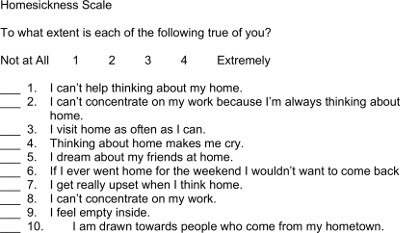観測研究
概要
ソース: ゲイリー Lewandowski デイブ Strohmetz ナタリー Ciarocco 所-マンモス大学
誰かが考えている方法を知りたい場合は感じている、その人を求めることができる質問。 別のアプローチは、人がどのように行動を観察したり、どのように彼らは、過去の行動の指標を探すことです。観測は明らかに思えるかもしれませんが、本当に正確なかどうか知っている容易ではない常に。例えば、人の笑顔を見るし、彼らを幸せな現実に悩まされているときは、単なる社交辞令と仮定可能性があります。
科学の目的は個々 のを超えて移動する、彼らは本質的に個人の期待、以前、個人の先入観、動機、感情などを体験が歪んでいるために自己の見解を所有します。人は、自己は、これらの洞察力は正確でない可能性があります 1 つのユニークな洞察力を持っているかもしれないが、現実を表してください。もっと簡単に言えば、何人は言う、常に一致しません彼らが実際に何でも。このため、研究者は、するためにさまざまな対策 (例えば、彼らの気持ちを報告する参加者を求めているが、実際の動作を観察することも) を組み込む必要があります詳細を正確にどのように人は本当に感じているキャプチャします。
このビデオは、研究者が 2 つの異なる方法で学生のホームシックを測定相関デザインを示します: (1) ホームシック スケールと (2) 学生が彼または彼女の寮の部屋に飾られて観察することによって。
心理学的研究は、しばしば他の科学研究よりも高いサンプル サイズを使用します。多数の参加者検討中の人口がよりよく表されることを確認することができます、すなわち、人間の行動を研究することによって伴うエラーのマージンは十分に占めております。このビデオでは、この実験のちょうど 1 つの参加者を示しています。ただし、な結果で表される実験の結論に到達するのに合計 63 人の参加者を使用しました。
手順
1. 主要な変数を定義します。
- ホームシックの運用の定義 (すなわち、まさにどのような研究者の手段概念の明確な説明) を作成します。
- ホームシックとは、苦悩と家と人に慣れていることから実際のまたは予想される分離による機能障害。(http://wellbeing.rice.edu/homesickness/)
2. 研究の簡単な説明およびプロシージャの感覚であるインフォームド コンセントを通し、参加者をリードします。
- 彼らがいくつかのアンケートを完了する求められます、研究者が彼らの寮部屋を見てするように求められますが参加者に通知します。
3. 参加者ホームシック スケール (図 1) とその他のいくつかの質問を含むパケットを与えます。
.css-f1q1l5{display:-webkit-box;display:-webkit-flex;display:-ms-flexbox;display:flex;-webkit-align-items:flex-end;-webkit-box-align:flex-end;-ms-flex-align:flex-end;align-items:flex-end;background-image:linear-gradient(180deg, rgba(255, 255, 255, 0) 0%, rgba(255, 255, 255, 0.8) 40%, rgba(255, 255, 255, 1) 100%);width:100%;height:100%;position:absolute;bottom:0px;left:0px;font-size:var(--chakra-fontSizes-lg);color:#676B82;}
結果
申請書と概要
参考文献
- Archer, J., Ireland, J., Amos, S., Broad, H., & Currid, L. Derivation of homesickness scale. British Journal of Psychology. 89 (2), 205-221. doi:10.1111/j.2044-8295.1998.tb02681.x (1998).
- Gosling, S. D., Ko, S., Mannarelli, T., & Morris, M. E. A room with a cue: Personality judgments based on offices and bedrooms. Journal of Personality and Social Psychology. 82 (3), 379-398. doi:10.1037/0022-3514.82.3.379 (2002).
- Back, M. D., Stopfer, J. M., Vazire, S., Gaddis, S., Schmukle, S. C., Egloff, B., & Gosling, S. D. Facebook profiles reflect actual personality, not self-idealization. Psychological Science. 21 (3), 372-374. doi:10.1177/0956797609360756 (2010).
タグ
スキップ先...
このコレクションのビデオ:

Now Playing
観測研究
Experimental Psychology
13.2K 閲覧数

理論から設計へ: 実験のデザインにおける創造性の役割
Experimental Psychology
18.7K 閲覧数

心理学研究における倫理
Experimental Psychology
29.3K 閲覧数

実験におけるリアリズム
Experimental Psychology
8.3K 閲覧数

実験心理学の展望
Experimental Psychology
5.7K 閲覧数

パイロット テスト
Experimental Psychology
10.3K 閲覧数

簡単な実験: 2 つのグループの設計
Experimental Psychology
74.5K 閲覧数

マルチ グループの実験
Experimental Psychology
22.9K 閲覧数

被験者内反復測定による設計
Experimental Psychology
23.1K 閲覧数

一部実施要因実験
Experimental Psychology
73.2K 閲覧数

リサイクルの行動対策と自己報告します。
Experimental Psychology
11.8K 閲覧数

心理学実験の信頼性
Experimental Psychology
8.6K 閲覧数

研究の中でプラシーボ
Experimental Psychology
11.6K 閲覧数

実施形態を独立変数を操作します。
Experimental Psychology
8.5K 閲覧数

南部連合国を用いた実験
Experimental Psychology
17.8K 閲覧数
Copyright © 2023 MyJoVE Corporation. All rights reserved
